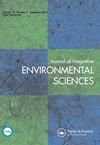气候变化脆弱性评估的联合生产:以大吉岭印度小喜马拉雅地区为例
IF 3.5
4区 环境科学与生态学
Q3 ENVIRONMENTAL SCIENCES
Journal of Integrative Environmental Sciences
Pub Date : 2022-03-24
DOI:10.1080/1943815X.2022.2033792
引用次数: 2
摘要
气候变化影响的强度和程度因景观的地理和生态结构而异。这在山地生态系统中尤其明显,因为地形、气候和生物梯度使山地生态系统极易受到全球环境变化的影响。在这样的地方景观上设计缓解和适应全球气候变化的战略,需要考虑到其特定特征的特定环境脆弱性。目前,在评估山地生态系统的气候变化脆弱性方面存在两个主要挑战:1)用于全球尺度脆弱性评估的模型正在地方尺度上使用,这些模型具有来自少数部门的广泛变量,无法捕捉山地生态系统的一系列特征;2)这些模型没有考虑到有关气候变化的土著知识,这使得减缓/适应措施的实施不太成功。在这项研究中,我们从印度小喜马拉雅地区(大吉岭)收集的数据中强调了这些问题。我们使用了一种混合研究方法,将脆弱性评估模型与参与式知识方法相结合。我们将气候变化脆弱性建立在山地景观社会生态系统的基础上。交互过程结果表明,在次区域层面上,大吉岭地区的气候变化脆弱性高于模型结果。我们强调了影响社会生态系统的关键变量,在评估脆弱性和未来适应情景时需要考虑这些变量。该研究为决策者规划气候缓解/适应措施和未来可持续性途径提供了决策支持过程。本文章由计算机程序翻译,如有差异,请以英文原文为准。
Co-production of climate change vulnerability assessment : A case study of the Indian Lesser Himalayan region, Darjeeling
ABSTRACT The intensity and extent of climate change impacts differ significantly with the geographical and ecological structure of the landscape. This is especially evident in mountain ecosystems where topographic, climatic and biological gradients make them extremely vulnerable to global environmental changes . Designing strategies to mitigate and adapt to global climate change on such local landscapes requires a context-specific vulnerabilities that take into account their particular characteristics. Presently, there are two main challenges in assessing climate change vulnerability in mountain ecosystems: 1) The models that are used for vulnerability assessments at global scales are being used at local scales with broad variables from few sectors that do not capture the range of characteristics of mountain ecosystems 2) indigenous knowledge about climate change are not considered in these models, which makes the implementation of mitigation/adaptation measures less successful. In this study, we highlight these issues drawing from our data collected in India’s Lesser Himalayan region (Darjeeling). We used a mixed research approach that combines a vulnerability assessment model with a participatory knowledge approach. We based climate change vulnerability around the socio-ecological system of the mountain landscape. The results from the interactive process showed that Darjeeling region is experiencing higher climate change vulnerability than the results produced by the model at the subregional level. We highlight critical variables that influence the socio-ecological system and need to be taken into account when assessing vulnerability and future adaptation scenarios. The study offers a decision support process for policymakers to plan climate mitigation/adaptation measures and future sustainability pathways.
求助全文
通过发布文献求助,成功后即可免费获取论文全文。
去求助
来源期刊

Journal of Integrative Environmental Sciences
ENVIRONMENTAL SCIENCES-
CiteScore
3.90
自引率
0.00%
发文量
13
审稿时长
>12 weeks
期刊介绍:
Journal of Integrative Environmental Sciences (JIES) provides a stimulating, informative and critical forum for intellectual debate on significant environmental issues. It brings together perspectives from a wide range of disciplines and methodologies in both the social and natural sciences in an effort to develop integrative knowledge about the processes responsible for environmental change. The Journal is especially concerned with the relationships between science, society and policy and one of its key aims is to advance understanding of the theory and practice of sustainable development.
 求助内容:
求助内容: 应助结果提醒方式:
应助结果提醒方式:


